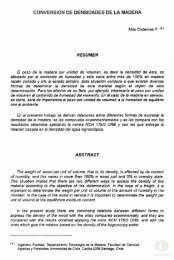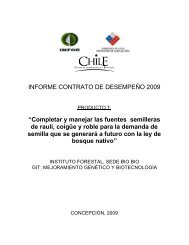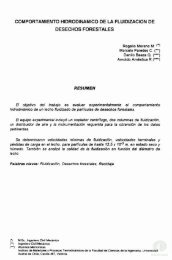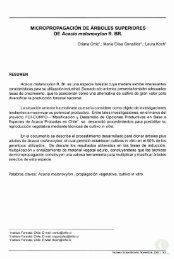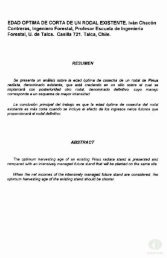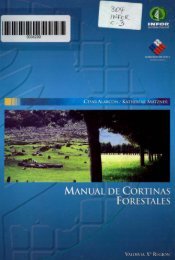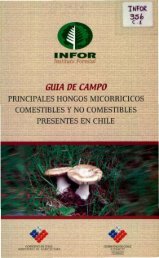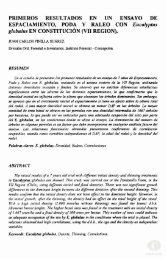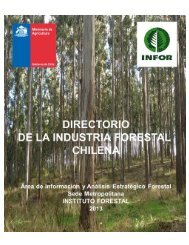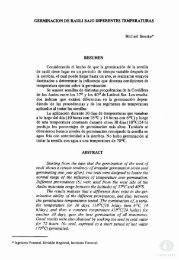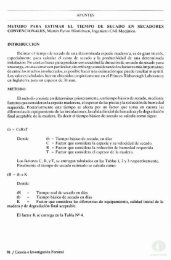inventario de las plantaciones de eucalipto de la vii region ... - Inicio
inventario de las plantaciones de eucalipto de la vii region ... - Inicio
inventario de las plantaciones de eucalipto de la vii region ... - Inicio
- No tags were found...
Create successful ePaper yourself
Turn your PDF publications into a flip-book with our unique Google optimized e-Paper software.
INVENTARIO DE LAS PLANTACIONES DE EUCALIPTODE LA VII REGIONR. Bennewitz, N. Vergara, J. Flores *RESUMENEste trabajo entrega los resultados <strong>de</strong>l <strong>inventario</strong> que elInstituto Forestal realizó en 1986 con el objetivo <strong>de</strong> prospectar<strong><strong>la</strong>s</strong> <strong>p<strong>la</strong>ntaciones</strong> <strong>de</strong> Eucalipto existentes en <strong>la</strong> VII Región, <strong>de</strong>terminando<strong>la</strong> superficie y <strong>la</strong> ubicación <strong>de</strong> los rodales, el tipo <strong>de</strong>monte, <strong>la</strong> altura media y los volúmenes por hectárea.Se aplicó <strong>la</strong> metodología tradicional que consiste en interpretarfotográficamente los límites <strong>de</strong> los rodales, obtener luegolos antece<strong>de</strong>ntes <strong>de</strong> terreno y, finalmente, e<strong>la</strong>borar <strong>la</strong> cartografíacorrespondiente y procesar los antece<strong>de</strong>ntes numéricos.Como resultados generales se logró <strong>de</strong>terminar que el área<strong>de</strong> estudio contiene 4.301 há <strong>de</strong> <strong>p<strong>la</strong>ntaciones</strong> <strong>de</strong> Eucalipto distribuidasen 625 rodales; el 66 0 /0 <strong>de</strong> <strong>la</strong> superficie <strong>de</strong> Eucalipto tieneentre 1 y JO años <strong>de</strong> edad; el 69 0 /0 <strong>de</strong> <strong><strong>la</strong>s</strong> <strong>p<strong>la</strong>ntaciones</strong> correspon<strong>de</strong>nal tipo monte bajo, el 25 0 /0 a monte alto y el 6 0 /0 restantea monte medio; el volument total <strong>de</strong> ma<strong>de</strong>ra en pie es <strong>de</strong>851.564 m' , <strong>de</strong> los cuales el 52 0 /0 está representado por el Eucaliptoque crece en monte alto; el volumen medio <strong>de</strong> <strong><strong>la</strong>s</strong> p<strong>la</strong>nta·eiones <strong>de</strong> Eucalipto <strong>de</strong> monte alto es <strong>de</strong> 466 m' sse por hectáreay el <strong>de</strong> <strong><strong>la</strong>s</strong> <strong>p<strong>la</strong>ntaciones</strong> <strong>de</strong> Eucalipto <strong>de</strong> monte bajo <strong>de</strong> 214 m' sscpor hectárea.AllSTRACfINFOR earrie" oUf all im'enlor)' in 1986 oflile Euealyplllsp<strong>la</strong>llfuliulIs in Region VII, fIJe jindings of which orf! !1resemccJ in,!lis papero nu: sun'cy <strong>de</strong>termined the arca ami/vcalivll vf rhestands, type uffurest. mean heigi1rs and vo/umes per heerare.A Iradilional methodology lVas applied. lVilieh eonsisls ofilllerprelillg pholOgraphieally lile bOUlldaries uf Ihe illdividuals<strong>la</strong>nds, galhering data ill lile freid and, filial/y, dralVillg Ihecorresponding charts alld maps, and processing lhe numericaldata.The sludy orea \Vas found 10 con<strong>la</strong>in 4,031 ha ofElIealyp·tus p<strong>la</strong>ntaliom dislribuled amon 625 s<strong>la</strong>nds. TIl'O lilirds of Ihe10101 orea eovered by Euealyplus have belWeen 1 and 10 years ofage: 6'.JOp of Ihe p<strong>la</strong>ll<strong>la</strong>lions eOrreSfXJtld lo eoppie
PLANTACIONES DE EUCALIPTO EN VII REGIONINTRODucaONLa creciente importancia que ha adquirido en el país <strong>la</strong> ma<strong>de</strong>ra <strong>de</strong> Eucalipto, utilizadaprincipalmente para fmes industriales, ha <strong>de</strong>spertado un gran interés por disponer <strong>de</strong> ¡nfannaciónactualizada acerca <strong>de</strong> <strong>la</strong> localización y características dasométricas <strong>de</strong> <strong><strong>la</strong>s</strong> masas existentesa nivel <strong>region</strong>al. El primer estudio <strong>de</strong>stinado a satisfacer esta necesidad, realizado por el InstitutoForestal, a petición <strong>de</strong> <strong>la</strong> Corporación <strong>de</strong> Fomento <strong>de</strong> <strong>la</strong> Producción, fue el "Inventario <strong>de</strong> <strong><strong>la</strong>s</strong>P<strong>la</strong>ntaciones <strong>de</strong> Eucalipto <strong>de</strong> <strong>la</strong> VII Región", cuyos resultados se dan a conocer en este trabajo.En el marco <strong>de</strong> <strong>la</strong> p<strong>la</strong>nificación <strong>de</strong>l uso <strong>de</strong> los recursos forestales, el estudio entrega antece<strong>de</strong>ntes<strong>de</strong> gran interés para el <strong>de</strong>sarrollo <strong>de</strong> políticas sectoriales, tanto a nivel estatal comoprivado. Complementariamente se exponen antece<strong>de</strong>ntes técnicos necesarios para iniciar prácticas<strong>de</strong> manejo intensivu <strong>de</strong> <strong><strong>la</strong>s</strong> <strong>p<strong>la</strong>ntaciones</strong> <strong>de</strong> Eucalipto existentes en <strong>la</strong> VII Región, tales C~010 tab<strong><strong>la</strong>s</strong> <strong>de</strong> volumen por árbol, rendimitmto por hectárea, superficies y eda<strong>de</strong>s.OBJETIVOSEl objetivo fundamental <strong>de</strong>l <strong>inventario</strong> fue prospectar <strong><strong>la</strong>s</strong> <strong>p<strong>la</strong>ntaciones</strong> <strong>de</strong>l género EucaIyptus existentes en <strong>la</strong> VII Región <strong>de</strong>l país (Región <strong>de</strong>l Maule), con el fin <strong>de</strong> obtener <strong>la</strong> ubica·ción geográfica <strong>de</strong> los rodajes, superficies. tipo <strong>de</strong> monte, altura media y volumen por hectárea.Para estos efectos se establecieron a<strong>de</strong>más los siguientes objetivos secundarios:a) E<strong>la</strong>boración <strong>de</strong> cartografía forestal en esca<strong>la</strong> 1: 50.000 con <strong>la</strong> localización <strong>de</strong> todas <strong><strong>la</strong>s</strong> <strong>p<strong>la</strong>ntaciones</strong><strong>de</strong>l género Eucalyptus <strong>de</strong> tamaño igual o superior a 1 ha existentes en el área <strong>de</strong> estudio.b) Cuantificación <strong>de</strong> <strong>la</strong> superficie cubierta por <strong>p<strong>la</strong>ntaciones</strong> <strong>de</strong>l género EucaIyptus a nivel <strong>region</strong>al,provincial y comunal, en <strong>la</strong> VII Región.c) Determinación <strong>de</strong>l tipo <strong>de</strong> monte, altura media y diámetro medio <strong>de</strong> todos los rodales <strong>de</strong>lgénero Eucalyptus <strong>de</strong> tamaño igual o superior a 5 ha existentes en <strong>la</strong> VII Región.d) Construcción <strong>de</strong> tab<strong><strong>la</strong>s</strong> <strong>de</strong> volumen cúbico por árbol para <strong>p<strong>la</strong>ntaciones</strong> <strong>de</strong> Eucalyprus globu·lus <strong>de</strong> monte alto y monte bajo.e) Estimación <strong>region</strong>al <strong>de</strong>l volumen cúbico <strong>de</strong> ma<strong>de</strong>ra en pie <strong>de</strong> <strong><strong>la</strong>s</strong> <strong>p<strong>la</strong>ntaciones</strong> <strong>de</strong>l géneroEucalyptus.ANTECEDENTES GENERALES DEL AREA DE ESTUDIOLa VII Región <strong>de</strong>l Maule se extien<strong>de</strong> aproximadamente entre <strong><strong>la</strong>s</strong> siguientes coor<strong>de</strong>nadasgeográficas: 34 0 45' a 36 0 30' <strong>de</strong> <strong>la</strong>titud Sur y 72 0 45' a 70 0 30' <strong>de</strong> longitud Oe,te (Ver Figura1).La VII Región cubre una superficie <strong>de</strong> 3.051.810 ha, que representan alre<strong>de</strong>dor <strong>de</strong>l4O¡b<strong>de</strong>l territorio nacional (Instituto Geográfico Militar, 1981). Existen en <strong>la</strong> Región 1.968.800 ha<strong>de</strong> uso silvoagropecuario, <strong>de</strong> <strong><strong>la</strong>s</strong> cuajes un 14O¡b correspon<strong>de</strong> a suelos agríco<strong><strong>la</strong>s</strong>, un 38O¡b a suelos<strong>de</strong> aptitud gana<strong>de</strong>ra y el 48O¡b restante a suelos con aptitud <strong>de</strong> uso forestal (Universidad <strong>de</strong> Chi·le, Se<strong>de</strong> Talea, 1975).En cuanto a su división administrativa, el área <strong>de</strong> estudio incluye cuatro provincias, queen conjunto poseen veintinueve comunas.78 Ilnfor Chile
R. BENNEWJTZ, N. VERGARA, J. FLORESFIGURA 1UBICACION DE LA VD REGION DEL MAULE,,.,,'~.fATERlAL Y MErODOMaterial: Para <strong>la</strong> realización <strong>de</strong>l presente estudio se utili<strong>la</strong>ron los siguientes materiales:Cartas topográficas e<strong>la</strong>boradas por el Instituto Geográfico Militar, en esca<strong>la</strong>50.000.Mapas forestales <strong>de</strong> predios ubicados en <strong>la</strong> VII Región en los cuales existen<strong>p<strong>la</strong>ntaciones</strong> <strong>de</strong> Eucalipto. Estos mapas se recopi<strong>la</strong>ron en <strong><strong>la</strong>s</strong> principales empresasforestales que poseen <strong>p<strong>la</strong>ntaciones</strong> en el área <strong>de</strong> estudio y en <strong><strong>la</strong>s</strong> oficinas provinciales<strong>de</strong> CON AF. En total se consultaron 66 mapas.Cartografia <strong>de</strong> roles <strong>de</strong> propiedad (según el Servivio <strong>de</strong> Impuestos Internos) enesca<strong>la</strong> 1: 100.000, procesada por CONAF VII Región, en base a los mosaicos <strong>de</strong>IREN en esca<strong>la</strong> 1: 20.000 y 1: 50.000.Cartografía forestal obtenida como resultado <strong>de</strong>l "Inventario <strong>de</strong> <strong><strong>la</strong>s</strong> P<strong>la</strong>ntacionesForestales <strong>de</strong> <strong>la</strong> VII Región", efectuado en 1981 por el Instituto Forestal paraCIREN . CORFO.Fotografias aéreas pancromáticas b<strong>la</strong>nco y negro, esca<strong>la</strong> 1: 30.000, Vuelo SAF1978/79.Volumen 1, Número 1, 1987/ 79
PLANTACIONES DE EUCALIPTO EN VII REGIONMétodo: La metodología utilizada por el estudio consultó <strong>la</strong> ejecución <strong>de</strong> <strong><strong>la</strong>s</strong> siguientes etapas:1. Recopi<strong>la</strong>ción <strong>de</strong> antece<strong>de</strong>ntes.2. Fotointerpretación <strong>de</strong> <strong><strong>la</strong>s</strong> <strong>p<strong>la</strong>ntaciones</strong> <strong>de</strong> Eucalipto.3. Trabajos <strong>de</strong> terreno.Control <strong>de</strong> <strong>la</strong> fotointerpretación,Mediciones básicas en todos los rodales <strong>de</strong> Eucalipto <strong>de</strong> tamaño mayor o igua<strong>la</strong> 5 ha.Muestreo <strong>de</strong> <strong><strong>la</strong>s</strong> <strong>p<strong>la</strong>ntaciones</strong> <strong>de</strong> Eucalipto,Obtención <strong>de</strong> una muestra para <strong>la</strong> e<strong>la</strong>boración <strong>de</strong> tab<strong><strong>la</strong>s</strong> <strong>de</strong> volumen por árbol.4. E<strong>la</strong>boración <strong>de</strong> cartografía forestal.5, Procesamiento computacional electrónico <strong>de</strong> <strong>la</strong> información (Ver Figuras 2 y 3),6. E<strong>la</strong>boración <strong>de</strong> <strong><strong>la</strong>s</strong> Tab<strong><strong>la</strong>s</strong> <strong>de</strong> Volumen.7. Procesamiento <strong>de</strong> <strong>la</strong> información referente a parce<strong><strong>la</strong>s</strong> <strong>de</strong> muestreo.8. Cálculo estadístico <strong>de</strong> <strong><strong>la</strong>s</strong> existencias volumétricas.9. Obtención <strong>de</strong> cuadros <strong>de</strong> resultados.FIGURA 2DIAGRAMA DE FLUJO SIMPLIFICADODEL SUBSISTEMA DE PROCESAMIENTODE LA INFORMACION PROVENIENTE DELAS PLANTACIONES FORESTALESFIGURA 3DIAGRAMA DE FLUJO SIMPLIFICADODEL SUBSISTEMA DE TABLAS DEVOLUMEN Y UNIDADES MUESTRALES."- '-80 / Jnfor Cltile
-. R. BENJIlEWITZ, N. VERGARA, J. FLORESRESULTADOSuperficieLa superficie total <strong>de</strong> <strong>p<strong>la</strong>ntaciones</strong> <strong>de</strong> Eucalipto existente en <strong>la</strong> VII Región <strong>de</strong>l Maule aleanzaa 4.301,3 ha, repartidas en un total <strong>de</strong> 625 rodales (Ver Cuadros I y 2).La provincia <strong>de</strong> TaIca es <strong>la</strong> que concentra <strong>la</strong> mayor extensión <strong>de</strong> <strong>p<strong>la</strong>ntaciones</strong> <strong>de</strong> Eucalipto(2.244,6 ha), seguida por Curicó (1.289,3 ha), Linares (456,1 ha) y Cauquenes (311,3 ha).En <strong>la</strong> provincia <strong>de</strong> Talca, el 59,2qb <strong>de</strong> <strong>la</strong> superficie <strong>de</strong> <strong>p<strong>la</strong>ntaciones</strong> <strong>de</strong> Eucalipto se concentcaen <strong>la</strong> comuna <strong>de</strong> Constitución. Las comunas <strong>de</strong> Río C<strong>la</strong>ro y San Clemente poseen en con·junto el 36,8 0 ,b <strong>de</strong> <strong>la</strong> superficie <strong>de</strong> <strong>p<strong>la</strong>ntaciones</strong> <strong>de</strong> Eucalipto existente en <strong>la</strong> provincia. No se<strong>de</strong>tectó presencia <strong>de</strong> Eucalipto en <strong><strong>la</strong>s</strong> comunas <strong>de</strong> Cucepto, Maule y Pencahue.En <strong>la</strong> provincia <strong>de</strong> Curicó, el 46,6qb <strong>de</strong> <strong>la</strong> superficie <strong>de</strong> <strong>p<strong>la</strong>ntaciones</strong> <strong>de</strong> Eucalipto se concentraen <strong>la</strong> comuna <strong>de</strong> Malina y el 28,4qb en <strong>la</strong> comuna <strong>de</strong> Curicó.En <strong>la</strong> provincia <strong>de</strong> Linares <strong>de</strong>stacan por su importancia <strong><strong>la</strong>s</strong> comunas <strong>de</strong> Linares, Yerbas Buenasy Colbún. <strong><strong>la</strong>s</strong> cuales concentran respectivamente el 29,Oqb, el 17,3qb y el 15,Oqb <strong>de</strong> <strong><strong>la</strong>s</strong>uperficie tO<strong>la</strong>l <strong>de</strong> Eucalpto <strong>de</strong> <strong>la</strong> provincia.CUADRO ISUPERFICIE DE PLANTACIONES DE EUCAUPTOPOR EDAD Y TIPO DE MONTEVII REGION- ----- - --~- - - -- - - - - --- -ED,'1l Sil MQNrE MONTE Mo",n TOT....L11';''''. tO·1 AUD 8"JO MEDIO ll'<strong>la</strong>l- - -------- - ---- - - - - -"s 'od.d EH,~.I S" 4)1'>.2I 24M 3 HIi 25'U ~¡¡J.l2 17.~ 42 ..\ 172.1,~.l' 117..' 110.0 ~45 11• " ~.H .1.'.0 ~7" J .114,1,"A1( •.\ 'JJ "".0'J "4.\.1 ll\1.5 '1M,7", 1.2 17.~ 48.7 67.48 LO 38.:,SIl.2 ""~Ii ~10 1>.2 211.11 "4.0 $9 o11.0 11,0J 1.0 10.U 21.0•.s 13" 211.50.8 '" S.O s.•J.5 10.11 14.3" 18 S.8 S.810.8 10.8"1.1 711 l.' 82.822 244 1.0 ~9,42J 2.8 11.5 30.8 45,18.2 8.2" 17 27.0 27.03.1 3.2"19 ., '.630 12.5 12.531 63.0 29.7 92.720.8 20.'" 33 9.1 l.' 7.0 22.0J712,339 '''' '.8 '.8
PLANTACIONES DE EUCALIPTO EN VII REGION- En <strong>la</strong> provincia <strong>de</strong> Cauquenes, el 52,89b <strong>de</strong> <strong>la</strong> superficie <strong>de</strong> <strong>p<strong>la</strong>ntaciones</strong> <strong>de</strong> Eucalipto se con·centra en <strong>la</strong> comuna <strong>de</strong> Chanco y el 32,39b en PeUuhue.Las <strong>p<strong>la</strong>ntaciones</strong> <strong>de</strong> Eucalipto localizadas en el área agríco<strong>la</strong> <strong>de</strong> <strong>la</strong> Depresión Intermedia <strong>de</strong> <strong>la</strong>VII Región están sujetas en su mayor parte a prácticas <strong>de</strong> riego y rotaciones <strong>de</strong> corta dura·ción.- El 66,I9b <strong>de</strong> <strong>la</strong> superficie con infonnación <strong>de</strong> edad corre¡pon<strong>de</strong> a <strong>p<strong>la</strong>ntaciones</strong> <strong>de</strong> Eucaliptocon eda<strong>de</strong>s comprendidas entre I y 10 años, en tanto que el I 1,79b Yel 22,29b están repre·sentados respectivamente por recurso cuya edad osci<strong>la</strong> entre 11 Y 20 años y entre 21 y másaños <strong>de</strong> edad ( Gráfico 1).ComunaCUADRO 2NUMERO DE RODALES DE EUCAUPTO SEGUN COMUNAY TIPO DE MONTEVllREGIONSIl (*)MonteAltoTipo <strong>de</strong> MonteMonteBajoMonteMedioTOTALCuricó 13Hua<strong>la</strong>ñé 2Licantén lMolina 20RaucoRomeralTeno 2Sagrada Familia 9VichuquénConstitución 24Empedrado IPe<strong>la</strong>rco 16Río C<strong>la</strong>ro 9Sn.Clemente 25Talca 9Colbún 4Linares 9Longavi 3Parral 2Retiro 9San Javier 7V iUa Alegre 6Yerbas Buenas 4Cauquenes 10Chanco 12PeUuhue 322I2I5741522274423468l72826831627I4134I564415577690I841871812193154JO102274JO8IIJO16248TOTAL 200 112 293 20 625NOTA: (*) Número <strong>de</strong> rodales sin infonnación <strong>de</strong>l tipo <strong>de</strong> monte.82 I Infor Chile
R. BENNEWITZ, N. VERGARA, J. FLORESLas <strong>p<strong>la</strong>ntaciones</strong> <strong>de</strong> Eucalipto <strong>de</strong> <strong>la</strong> VII Región son fundamentalmente <strong>de</strong> monte bajo. El699b <strong>de</strong> <strong>la</strong> superficie <strong>de</strong> <strong>p<strong>la</strong>ntaciones</strong> <strong>de</strong> Eucalipto con información <strong>de</strong> tipo <strong>de</strong> monte corres·pon<strong>de</strong> a monte bajo, en tanto que el 24,79b y e16,39b están representados por <strong>p<strong>la</strong>ntaciones</strong><strong>de</strong> monte alto y monte medio respectivamente (Ver Gráfico 2).Regimen <strong>de</strong> PropiedadEl 909b <strong>de</strong> <strong>la</strong> superficie <strong>region</strong>al <strong>de</strong> <strong><strong>la</strong>s</strong> <strong>p<strong>la</strong>ntaciones</strong> <strong>de</strong> Eucalipto con información dc propieda<strong>de</strong>stá en manos <strong>de</strong>l sector privado, en tanto que <strong>la</strong> propiedad estatal alcanza sólo alIO,09b <strong>de</strong> <strong>la</strong> superficie.El 94,39b <strong>de</strong>l número <strong>de</strong> rodales <strong>de</strong> Eucalipto con información <strong>de</strong> propiedad, pertenecen alsector privado, en tanto que sólo el S,79b son <strong>de</strong> propiedad estatal.GRAFICO ID1STRlBUCION PORCENTUAL POR CLASES DE EDAD DE LA SUPERFICIE Y NUMERODE RODALES DE EUCALIPTO DE LA VD REGION10090P 1lIo 10r6
PLANTACIONES DE EUCALIPTO EN VII REGIONGRAFIC03DISTRIBUCION DEL NUMERO DE PROPIETARIOS Y DE LA SUPERFICIE TOTAL DEPL~ACIONES DE EUCALIPTO CON INFORMACION DE PROPIEDAD, SEGUNCLASE DE TAM~ODE LA P~ACION",• ,*~• ••, p, I, •, •, ,.1-10 11410 21-JO 3'-'0 u-!IO !>1-100 101-100 lOl,.0...- .... r__ ... lopl........... I~11p, '"1... n.o.. d. ¡,..,nu~. l. p<strong>la</strong>••",,,,,, ,h••El 70,7"P <strong>de</strong> <strong>la</strong> superficie total <strong>de</strong> <strong>p<strong>la</strong>ntaciones</strong> <strong>de</strong> Eucalipto (3.030,4 ha) está en manos <strong>de</strong>140 propietarios, <strong>de</strong> los cuales <strong>la</strong> mitad poseen superficies <strong>de</strong> 1 a 1Oha <strong>de</strong> bosque. Aun cuan·do <strong>la</strong> cifra <strong>de</strong> pequei\os propietarios es elevada, <strong>la</strong> superficie total que ellos poseen es re<strong>la</strong>tiva·mente pequeña, ya que sólo correspon<strong>de</strong> al 13,4,*> <strong>de</strong> <strong>la</strong> superficie con información <strong>de</strong> propiedad(Ver Gráfico 3).Las <strong>p<strong>la</strong>ntaciones</strong> <strong>de</strong> Eucalipto tien<strong>de</strong>n a estar concentradas en pocos propietarios. ya que1.402.6~e <strong>la</strong> superficie <strong>region</strong>al están en manos <strong>de</strong> 15 propietarios, <strong>de</strong> los cuales 4 poseenen conjunto 787,7 ha (Gráfico 3).YolumetríoTablos y Funciones <strong>de</strong> Volumen Cúbico por A,bol: El procedimiento <strong>de</strong> regresión paso a paso,junto con un análisis <strong>de</strong> los residuos <strong>de</strong> cada mo<strong>de</strong>lo, permitió <strong>de</strong>sarrol<strong>la</strong>r el siguiente mo<strong>de</strong>lomatemático:¡¡nVOl ~ a+bln(Jn(DAP2HT) ILos coeficientes <strong>de</strong>l mu<strong>de</strong>lo y <strong><strong>la</strong>s</strong> características <strong>de</strong> cada ajuste se presentan en el Cua·dro 3.84 / Inror Chile
R. BENNEWITZ. N. VERGARA, J. FLORESCUADRO 3FUNCIONES DE VOLUMEN CON Y SIN CORTEZA HASTA UN DIAMETRODE UnUZACION DE 10 CMCoeficientes <strong>de</strong>Indicadores <strong>de</strong> GradoRegresión<strong>de</strong> AjusteTi'po TipoMonte Volumen a b r Syx: ('lb) tb nAlto Con Corteza - 22,9473 9,8328 0,9884 17,2 77,4 143AJto Sin Corteza - 23,5880 10,019 0,9875 18,7 74,5 143Bajo Con Corteza - 20.8000 8,8864 0,9822 24,3 65,0 157Bajo Sin Corteza - 20,1935 8,5291 0,9865 23,0 75,3 157Don<strong>de</strong>:VOL = Volumen con o sin corteza hasta un diámetro <strong>de</strong> utilización <strong>de</strong> 10 cm (m3¡árbol)DAP Diámetro a <strong>la</strong> altura <strong>de</strong>l pecho (cm)HT = Altura total <strong>de</strong>l árbol (m)a, b = Coeficientes <strong>de</strong> regresiónr ::; Coeficiente <strong>de</strong> corre<strong>la</strong>ciónSyx (9b)= Error cuadrático medio (9b)tb ::; Valor "t" <strong>de</strong> 5tu<strong>de</strong>nt <strong>de</strong>l coeficiente "b"n = Número <strong>de</strong> observacionesGRAFlC04FUNCIONES DE VOLUMEN SIN CORTEZA, POR TIPO DE MONTE"'01,.l.""\t".
PLANTACIONES DE EUCALIPTO EN VII REG<strong>la</strong>NHmciones <strong>de</strong> Volumen por Hectárea. La cubicación <strong>de</strong> <strong><strong>la</strong>s</strong> parce<strong><strong>la</strong>s</strong> <strong>de</strong> muestreo <strong>de</strong> volumenpermitió establecer re<strong>la</strong>ciones entre el volumen, <strong>la</strong> altura y el área basal. En base a <strong><strong>la</strong>s</strong> ten<strong>de</strong>nciasobtenidas se e<strong>la</strong>boraron <strong><strong>la</strong>s</strong> siguientes funciones <strong>de</strong> volumen por hectárea:VOL ~-O,075xH1.043,895 (1 - e )7,5840con nrSyx('lb)= 87=0,8257= 4O,5'lbVOL-O,OJ2xAB1.869,822 (I-e )1,5519can n = 87r =0,9682Syx (".*» = 18,O'lbIlnVOL-0,72950 + 0,9586 In (AB x H)con n = 87r = 0,9951Syx ('lb) = 16,7".*>Don<strong>de</strong>:VOL Volumen cúbico (111 3 sse/ha)AIJ Arca Basal (012/ha)H Altura media <strong>de</strong>l rodal (m)Olras Re<strong>la</strong>ciones HU/duna/es. La muestra <strong>de</strong> árboles utilizada para <strong>la</strong> e<strong>la</strong>boración <strong>de</strong> <strong>la</strong> tab<strong>la</strong> <strong>de</strong>volumen pcnnitió obtener <strong><strong>la</strong>s</strong> siguienlcs re<strong>la</strong>ciones funcionales para mOnte alto y monte bajo:Monte alto (n =143 observaciones)1,7796-O,055xDAPHT = 48,9427 (t -e )r = 0,7685Syx = 16,8'lbHC-7,9533 + 1.0691 x HTr =0,9826Syx = 6,3'lb86 Ilnfor Chile
R. BENNEWITZ, N. VERGARA, J. FLORESMonte bajo (n ~157 observaciones)HT-0,0272xDAP~ 60,5338 (l-e )r ~ 0,8425Syx ~ 17,9"P1,10552HC-10,6238 + l,ll24x HTr ~ 0,9736Syx ~ 12,l'lbDon<strong>de</strong>:HT : Altura total (m)HC : Altura comercial para un diámetro <strong>de</strong> utilización <strong>de</strong> lO cm (m)DAP: Diámetro a <strong>la</strong> altura <strong>de</strong>l pecho (cm)1'.'XiSlenc;as Volum¿tricas- El volumen total <strong>de</strong> ma<strong>de</strong>ra en pie <strong>de</strong> <strong><strong>la</strong>s</strong> <strong>p<strong>la</strong>ntaciones</strong> <strong>de</strong> Eucalipto localizadas en <strong>la</strong> VII Re·gión, hasta un índice <strong>de</strong> utilización <strong>de</strong> lO cm, alcanza a 851.564 10 3 sólidos sin corleza.- El error <strong>de</strong> muestreo <strong>de</strong>l Volumen Medio Regional <strong>de</strong> ma<strong>de</strong>ra en pie es <strong>de</strong> un IO,O'lb para uncoeficiente <strong>de</strong> confianza <strong>de</strong> 9S~. Consi<strong>de</strong>rando dicho error <strong>de</strong> muestreo, pue<strong>de</strong> afinnarseque el volumen medio <strong>de</strong> ma<strong>de</strong>ra en pie <strong>de</strong> <strong><strong>la</strong>s</strong> <strong>p<strong>la</strong>ntaciones</strong> <strong>de</strong> Eucalipto <strong>de</strong>l área <strong>de</strong> .estudioOuctúa entre 770 y 940 mil metros cúbicos sólidos sin corleza.- De <strong>la</strong> existencia volumétrica <strong>region</strong>al, un 52~ correspon<strong>de</strong> a <strong>p<strong>la</strong>ntaciones</strong> <strong>de</strong> monte alto; <strong>la</strong>fracción restante equivalente al 489b <strong>de</strong>l volumen, correspon<strong>de</strong> a mOnte bajo.- El volumen medio por hectárea alcanza a 214 013 ssc en <strong><strong>la</strong>s</strong> <strong>p<strong>la</strong>ntaciones</strong> <strong>de</strong> monte bajo y a466 m3 ssc en <strong><strong>la</strong>s</strong> <strong>p<strong>la</strong>ntaciones</strong> <strong>de</strong> monte alto.Volumen 1, Número 1, 1987/ 87
PLANTACIONES DE EUCALIPTO EN VII REGlONREFERENCIA BIBLIOGRAFlCACORPORACION NACIONAL FORESTAL 1985. Boletín Técnico NO 25. Funciones <strong>de</strong> Volumen Cúbicopara <strong>la</strong> Especie Euca!yptus g/obu/us LAbill, <strong>de</strong> Monte Bajo en <strong>la</strong> Región Metropolitana. Santiago, Chile.74 p.CORPORACION NACIONAL fORESTAL 1986. Boletín Técnico NO 28. Tab<strong><strong>la</strong>s</strong> Generales <strong>de</strong> Producción <strong>de</strong>Leña para I::ucolyptus globulus Labill en <strong>la</strong> Región Metropolitana. Santiago, Chile. 87 p.FLORES. J. 1983. Proposición <strong>de</strong> una Metodología para Cubicar Arboles <strong>de</strong> PinUSTodiato D. Don. Tesis log.For. Santiago, Universidad <strong>de</strong> Chile, Facultad <strong>de</strong> Ciencias Agrarias, Veterinarias y Forestales. Santiago.62 p.HERNANDEZ. M. y MORALES, H. 1985. Evaluación <strong>de</strong> <strong>la</strong> productividad <strong>de</strong> Euca/yptus spp. bajo diferentescondiciones <strong>de</strong> sitio VI a IX Región. Tesis Ing. Fo!. Santiago, Universidad <strong>de</strong> Chile, Facultad <strong>de</strong>Ciencias Agrarias, Veterinarias y Fore·stales. Santiago. 131 p.INSTITUTO DE RECURSOS NATURALES 1979. Perspectivas <strong>de</strong> Desarrollo <strong>de</strong> los Recursos e <strong>la</strong> VII Re·gión. Publicación NO 25. Santiago, Chile, IREN - CORfO. Tomo X: GEODEMOGRAFlA y TomoVIII (Análisis <strong>de</strong> los Recursos Forestales).INSTITUTO FORESTAL 1986. Estadísticas Forestales 1985. Santiago, Chile, INFOR-cORFO, Serie InformáticaNO 34, junio 1986,98 p.INSTITUTO GEOGRAFICO MILITAR 1981. At<strong><strong>la</strong>s</strong> Regionalizado <strong>de</strong> Chile. Santiago, Chile,Instituto Geográtlco Militar. 2da. Edición.INSTITUTO GEQGRArlCO MILITAR 1983. Gcografía <strong>de</strong> Chilc, V, 3: Biografía. Santiago,Chile. Instituto Geográfico Militar. 230 p.INSTITUTO GEOGRAFlCO MILITAR 1983. At<strong><strong>la</strong>s</strong> <strong>de</strong> <strong>la</strong> República <strong>de</strong> Chile. Santiago. Chile, InstitutoGeográfico Militar, 2da. Edición. 349 p.lEHMA , W. WAlTER 1967. Construcción <strong>de</strong> Tab<strong><strong>la</strong>s</strong> <strong>de</strong> Volumen para Euca/iptus g/obulus LabiII en <strong>la</strong>zona costera Centro·Norte. Tesis Ing. Foro VaIdivia. Universidad <strong>de</strong> Chile, Escue<strong>la</strong> <strong>de</strong> IngenieríaForestal. 69 p.LISBOA, H. ) 960. Construcción <strong>de</strong> Tab<strong><strong>la</strong>s</strong> <strong>de</strong> Volumen para Euca/yplUs globulus LabiJI. Tesis Ing. For.Santiago, Universidad <strong>de</strong> Chile, Facultad <strong>de</strong> Ciencias. Forestales, 45 p.LUTTECKE. KLAUS 1983. Análisis Técnico y Económico <strong>de</strong> Mediciones Lineales <strong>de</strong>l Fuste por Medio <strong>de</strong>lRe<strong><strong>la</strong>s</strong>copio <strong>de</strong> Banda Ancha <strong>de</strong> Bitterlich. Universidad <strong>de</strong> Chile. Facultad <strong>de</strong> Ciencias Agrarias, Vete·rinarias y forestales. Santiago. 58 p.RIBALTA, E. 1983. Evaluación <strong>de</strong> <strong>la</strong> Producción y Productividad <strong>de</strong>l Monte Bajo <strong>de</strong> /:;uca/ypcus g/obulusLabiII V Región. Tesis Ing. Forestal. Santiago, Universidad <strong>de</strong> Chile. Facultad <strong>de</strong> Ciencias Agrarias.Veterinarias y Forestales. 128 p.SEPULVEDA, S. J962. Síntesis Regional en: Geografía Económica <strong>de</strong> Chile. Tomo IV. Corporación <strong>de</strong>fomento. Editorial Universitaria. Santiago. Chile.UNIVERSIDAD DE CHILE - SEDE TALCA 1975. Primera y Segunda Jornadas <strong>de</strong> Recursos NaturalesRenovables <strong>de</strong> <strong>la</strong> Región <strong>de</strong>l Maule. Acta Reunión final.88 Ilnfor Chile



